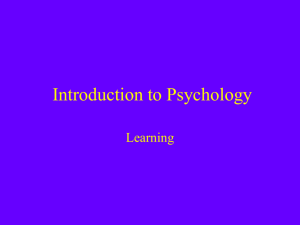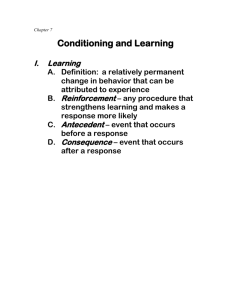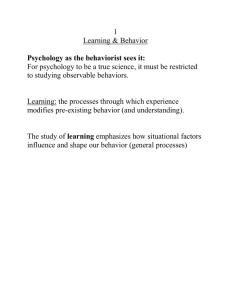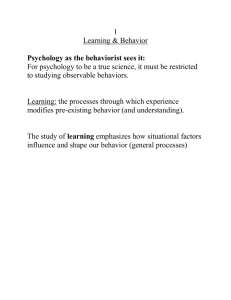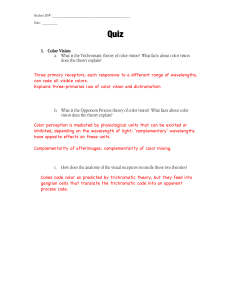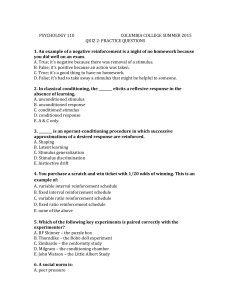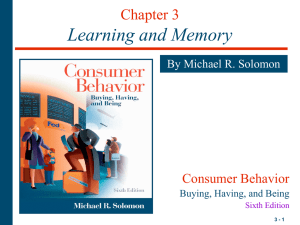Psychology Learning Notes: Classical & Operant Conditioning
advertisement
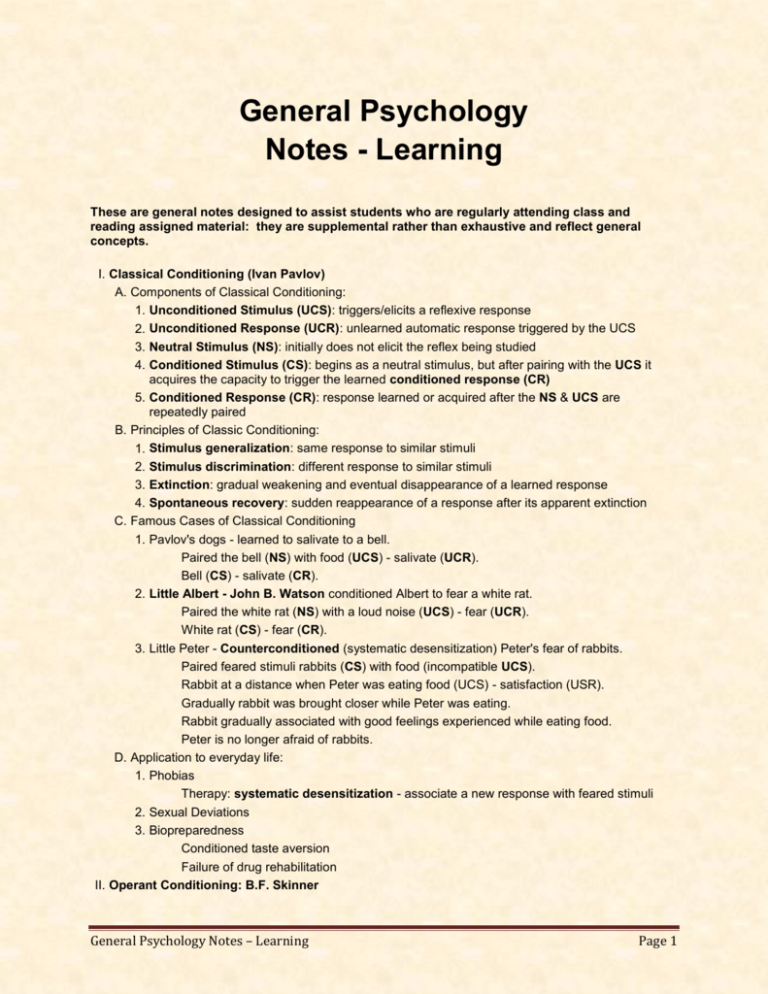
General Psychology Notes - Learning These are general notes designed to assist students who are regularly attending class and reading assigned material: they are supplemental rather than exhaustive and reflect general concepts. I. Classical Conditioning (Ivan Pavlov) A. Components of Classical Conditioning: 1. Unconditioned Stimulus (UCS): triggers/elicits a reflexive response 2. Unconditioned Response (UCR): unlearned automatic response triggered by the UCS 3. Neutral Stimulus (NS): initially does not elicit the reflex being studied 4. Conditioned Stimulus (CS): begins as a neutral stimulus, but after pairing with the UCS it acquires the capacity to trigger the learned conditioned response (CR) 5. Conditioned Response (CR): response learned or acquired after the NS & UCS are repeatedly paired B. Principles of Classic Conditioning: 1. Stimulus generalization: same response to similar stimuli 2. Stimulus discrimination: different response to similar stimuli 3. Extinction: gradual weakening and eventual disappearance of a learned response 4. Spontaneous recovery: sudden reappearance of a response after its apparent extinction C. Famous Cases of Classical Conditioning 1. Pavlov's dogs - learned to salivate to a bell. Paired the bell (NS) with food (UCS) - salivate (UCR). Bell (CS) - salivate (CR). 2. Little Albert - John B. Watson conditioned Albert to fear a white rat. Paired the white rat (NS) with a loud noise (UCS) - fear (UCR). White rat (CS) - fear (CR). 3. Little Peter - Counterconditioned (systematic desensitization) Peter's fear of rabbits. Paired feared stimuli rabbits (CS) with food (incompatible UCS). Rabbit at a distance when Peter was eating food (UCS) - satisfaction (USR). Gradually rabbit was brought closer while Peter was eating. Rabbit gradually associated with good feelings experienced while eating food. Peter is no longer afraid of rabbits. D. Application to everyday life: 1. Phobias Therapy: systematic desensitization - associate a new response with feared stimuli 2. Sexual Deviations 3. Biopreparedness Conditioned taste aversion Failure of drug rehabilitation II. Operant Conditioning: B.F. Skinner General Psychology Notes – Learning Page 1 A. Background 1. Based his theory on Edward Thorndike's Law of Effect: - if a response made to a stimulus is followed by satisfaction that response is more likely to occur the next time the stimulus is present. 2. Skinner concluded that an organism learns a response by trying actions that operate on the environment and a response is more or less likely to occur depending on its consequences. B. Consequences 1. Reinforcement - increases the likelihood of a response Positive reinforcement - give something pleasant to increase the response/behavior Negative reinforcement - take away something unpleasant to increase the response Primary reinforcers - satisfy needs basic to survival (food) Secondary reinforcers - conditioned reinforcers through association (money) 2. Punishment - decreases the likelihood of a response Positive punishment - give something unpleasant to decrease the reponse Negative punishment - take away something pleasant to decrease the response Primary punisher - naturally painful to an organism (shock) Secondary punisher - conditioned punishers through association (frown) C. Principles 1. Extinction 2. Stimulus generalization 3. Stimulus discrimination 4. Discriminative stimuli - signals a consequence will occur if a certain response is made. Ex: Mr. Yuk replaces Skull and Cross bones to signal dangerous poison 5. Shaping - reinforce successive approximations to the target behavior or desired goal 6. Escape conditioning - learn to make a response that removes an unpleasant stimulus D. Schedule of Reinforcement: 1. Fixed Ratio (FR): Reinforcement after a specific number of responses have been given EX: FR1 - one piece of candy for every correct answer FR3 - one food pellet for pressing the bar three times 2. Variable ratio (VR): Reinforcement given after an average number of responses given EX: VR5 - a slot machine will pay off on an average of 5 quarters being played (pay off may be 4, 5, or 6) 3. Fixed Interval (FI): Reinforced after a specific amount of time has lapsed since last reinforcer 4. Variable Interval (VI): Some variation in the time when reinforcement will occur EX: Mailman comes around 2:00 everyday. Sometimes 1:30, 1:45, 2:00, 2:30. E. Punishment and Learning 1. Drawbacks of using Punishment: * Doesn't erase undesirable behavior only suppresses it. * Unwanted side effects (fear, anger, revenge) in person being punished. * Difficult to give punishment immediately. * Difficult to administer justly (due to punisher's emotions can lead to abuse). * Does not teach desirable or appropriate behavior. * Encourages "how not to get caught" behavior (lying, sneaking). 2. Effective use of Punishment * Used minimally. General Psychology Notes – Learning Page 2 * Explain why punishment is being used. * Discuss appropriate and desirable behavior. * Emphasize that behavior is bad not child. * Punishment should be used immediately after offense and fit the crime. * Reinforce appropriate behavior. F. Other Cognitive Processes in Learning 1. Learned Helplessness - tendency to give up any effort to control environment 2. Social Learning (Albert Bandura) - people learn through imitation and observation General Psychology Notes – Learning Page 3
